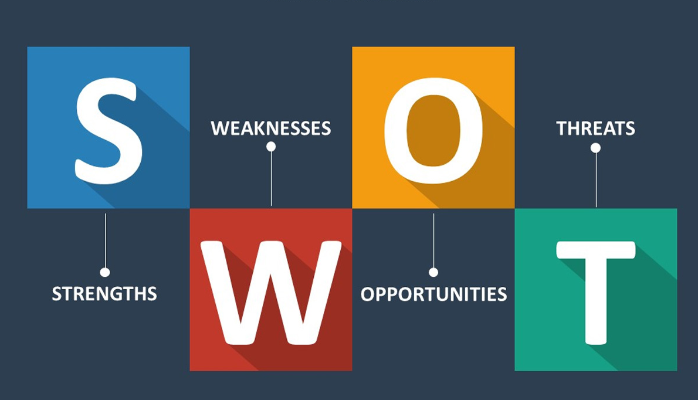SWOT Analysis is an invaluable strategic planning tool that assists individuals, companies, and organizations alike with understanding their strengths and weaknesses as well as external threats and opportunities. It offers an all-inclusive method of evaluating the present status of projects/businesses/situations/environments to make informed decisions based on this data. In this article, we’ll go over steps for conducting a SWOT Analysis table and look at various examples to show you its use in strategic planning.
1. What Is A SWOT Analysis
A SWOT analysis refers to Strengths, Weaknesses Threats (SWATs), and Opportunities (Opp) as an evaluation framework used for goal and objective setting. It serves to understand all external as well as internal factors that might negatively influence goals or objectives and to find possible ways to address any possible weaknesses or threats to them.
Strengths These internal factors that give your company an advantage over others could include experience and resources available as well as any factor that aids you in meeting goals more quickly and successfully.
HTML0’s weaknesses: Internal obstacles or benefits that might impede or accelerate your progression could pose barriers, whether they involve a lack of resources, knowledge or anything else that holds them back from reaching their full potential.
Opportunity: External factors you can exploit in your favor such as market trends or technology advances that benefit you can present themselves as opportunities.
Risks: External elements that might thwart your business goals could present significant threats, including economic downturns or competition from outside sources.
Why Is SWOT Analysis Essential to Strategic Planning? Strategic planning: SWOT Analysis helps provide an in-depth picture of present conditions to aid strategic decision-makers with decision-making processes.
Making Decisions: Decision analysis assists in decision-making by pinpointing areas in which strengths, opportunities, and risks can be exploited or diminished in order to reduce risks or weaknesses.
Risk evaluation: This tool assists organizations with assessing and mitigating risks by highlighting any threats present.
Also Read: what-is-a-conductor
2. How to Conduct a SWOT Analysis
Step 1: Outline Objectives
To get the best out of conducting a SWOT Analysis, the first step should always be identifying your objectives or desired goals – these could relate to an enterprise, project, or personal growth goals.
Step Two: Collect Information
Gather any necessary data or information related to your topic through surveys, research studies or data analyses if possible and consider seeking input from stakeholders as required.
Step 3: Construct a SWOT Analysis Table
To organize your results effectively, designate each quadrant as Opportunities, Strengths, Weaknesses or Threats in your table.
Step 4: Analyse and Prioritize
Utilize all the data that has been compiled. Be objective and honest in your evaluation; prioritize those aspects which are the most essential.
Step 5: Draft Strategies
Upon reviewing the findings from your analysis, devise strategies that take advantage of strengths and opportunities while at the same time addressing weaknesses and mitigating danger.
3. Sample SWOT Analysis Table
Here is an example table for SWOT Analysis:
| Strengths | Weaknesses | |
|---|---|---|
| Internal | – Strong brand | – Limited budget |
| Factors | – Skilled staff | – Small market |
| – Innovative | – Lack of scale | |
| – Efficient | – Dependence on one supplier | |
| – Inadequate marketing |
| Opportunities | Threats | |
|---|---|---|
| External | – Emerging markets | – Intense competition |
| Factors | – Technological | – Economic downturn |
| advancements | – Regulatory changes | |
| – Growing demand | – Supplier issues | |
| – Strategic | – Changing consumer | |
| partnerships | preferences |
4. SWOT Analysis Examples
To provide some context to a SWOT Analysis exercise, let’s consider an example from a small bakery conducting its analysis.
Advantages High-quality items and loyal customers; Weaknesses Limited marketing budget; Small space. Potential: Rising demand for homemade baked goods in local food trends. Risks Competition from larger bakeries with fluctuating food costs (SWOT analysis). mes [Personal SWOT Analysis].
Also Read: understanding-ip-addresses-definition-and-explanation
An individual could utilize an analysis of SWOT for personal growth:
Strengths include strong work ethics and technical abilities; weaknesses include limited networking experience.
Opportunities may include online courses for skill development as well as job market growth opportunities; threats may come in the form of risks to economic outlook and competition for employment market space – these factors all factor into Project SWOT Analysis.
An experienced project manager could conduct SWOT analyses on software projects:
Strengths include having an experienced development group and effective project management, tight deadlines and budget restrictions are weaknesses, potential opportunities include new technologies as well as partnerships being possible and risks such as changing requirements or security threats present risk to this project.
Conclusion
A SWOT analysis can be an extremely versatile tool that can provide invaluable information when used strategically or for personal decision-making purposes. By identifying strength-and-weaknesses analysis as opportunities threats weaknesses individuals and businesses alike can identify strategies to overcome challenges while capitalizing on strengths to find success with project or personal management efforts or development processes. A thorough SWOT evaluation may prove indispensable to achieve positive outcomes with any endeavour or venture undertaken.
